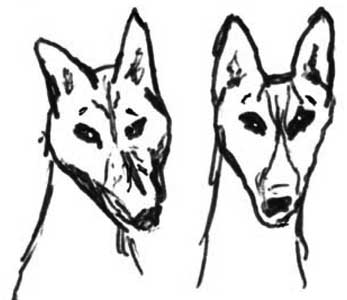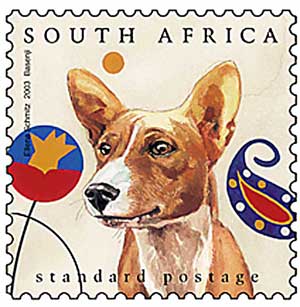Page 8 & 9 < previous page > <next page>
SOME HEALTH NEWS
1. Regarding eye exam certification
2. New prefix to Dr. Gonto's fanconi protocol
|
FOR IMMEDIATE RELEASE: OFA AND ACVO ESTABLISH NEW EYE CERTIFICATION REGISTRY AND CLINICAL DATABASE FOR OPHTHALMIC DIAGNOSES
Columbia, Missouri, Friday, August 31, 2012 The Orthopedic Foundation for Animals (OFA) and the American College of Veterinary Ophthalmologists (ACVO) are pleased to announce the establishment of a new joint Eye Certification Registry (ECR) and Clinical Database for Ophthalmic Diagnoses (CDOD) effective November 1, 2012. Together, the ECR and CDOD will be important tools to monitor canine inherited eye conditions and reduce their incidence.
OFA Eye Certification Registry exams are ophthalmic examinations, performed by ACVO Diplomates, to assess dogs for the presence or absence of observable hereditary ocular disease.
Dogs with normal exam results will receive OFA eye certification numbers valid for one year. Eye Certifications are an important part of the routine health screening practiced by responsible dog breeders to produce healthy puppies. Recognizing that animals presenting for a Certification Exam represent a biased population of primarily normal dogs, the CDOD will capture aggregate statistics regarding disease prevalence for those animals presented to ACVO Diplomates in private and institutional clinical practices.
The OFA currently maintains the world’s largest online database of canine health screening results. The addition of eye exam results will enhance the value of this important toolset for responsible breeders to make more informed breeding decisions to reduce the incidence of inherited disease. For informed puppy buyers, the database provides documentation of a breeder’s health screening efforts. A portion of the proceeds from all OFA eye registrations will be donated to the ACVO Vision forAnimals Foundation to support research leading to the elimination of ocular diseases causing vision loss and suffering in animals. For more information please visit the OFA website at www.offa.org CONTACT: Eddie Dziuk OFA, Columbia, MO tel: (573) 442-0418
Founded in 1966, the OFA is a not-for-profit foundation with the mission to promote the health and welfare of companion animals through a reduction in the incidence of genetic disease. The ACVO promotes excellence in veterinary ophthalmology through advanced training, certification, research and education.
|
CERF’s position, as I read it, is basically you can pay them or pay OFA for certifying/reporting the exam results. Of course, they hope you’ll be tried & true & stick with them. September 26, 2012 Dear CERF Breeder, Due to the recent developments, I’d like to take a few moments in order to clarify the current situation with OFA. We at CERF were completely taken by surprise when informed on August 1st that OFA would be creating an alternate registration source. OFA did not communicate with CERF before this announcement was made. This new registry is a separate organization from CERF. CERF is not merging with OFA, nor are we being acquired by OFA. CERF will remain an independent entity and will continue its close working relationship with OFA and ACVO Diplomates. You can continue to request CERF examinations when making appointments with your ACVO Ophthalmologist. CERF will continue using its current policy for posting exam results. Unlike the OFA model, breeders have the option to release or withhold their registration information to the public.
Despite the many strengths that CERF possesses, we recognize that there is always room for improvement. We are striving to expedite examination and registration of eye exams. We are in the process of redesigning our databases, expanding our web presence and adding other features to improve timely access to CERF data. We have hired an external consultant for a fresh perspective on our operations. We are firmly committed to providing the highest quality of service. We strongly believe that CERF, with over 30 years of experience, has the knowledge and expertise needed to provide superior results. In short, CERF isn’t going away any time soon.
I would certainly like to continue working with everyone that has supported CERF in the past as we navigate this complicated situation. I greatly appreciate everyone that continues to support CERF. Only through your continued efforts is CERF able to collect data and provide these valuable services. I can assure you that all of our current data is safe, and will remain accessible regardless of the outcome of this matter. Please feel free to contact me at any time if you have any concerns or suggestions. I hope that I can count on you for continued support.
Sincerely, Robert Malinowski, DVM, MA President, VMBD/CERF  Ringo & Nika, Sailor drawing |
Fanconi Protocol Primer
DO NOT EDIT. If you share, Dr Gonto has requested it be copied in full as it is.
An introduction to the REPLACEMENT for the 2003 Protocol
This information is now distributed to vets consulting with Dr. Gonto.
Written and approved for posting by Steve Gonto, M.M.Sc., Ph.D.
We have learned much about Fanconi in the last 25 or so years of using and refining the treatment Protocol, but we again entered a STEEP learning curve when the new GENETIC test came about, and revealed in short order that our prior thought that glucosuria was time related to bicarbonate loss and thus a good indicator of "onset" of the disease, was, in a word, WRONG. We now see many dogs, NOT glucosuric, and far younger then the "three years of age" which we though was the youngest that dogs onset, as already losing bicarbonate.
In a way, I realize that hindsight is always 20/20, but since we treat our HUMAN Fanconi patients as infants (newborns, really), I don't know why we ever thought that a Fanconi patient that is canine might "only" onset solate. Of course, other then PU/PD and GLUCOSURIA, what else was there to see inthese patients. We were not going to do regular, serial blood gasses on ALL Basenjis, thinking to catch an "early" bicarbonate loser, even if we had known about this phenomenon years ago. It was the advent of the GENETIC test that "re-wrote" the book, and made us do a few" baseline" gasses that turned out to be anything but "baseline", discovering affliction at a FAR earlier then expected age.
Now, before even going on about (YOUR DOG), even the Protocol is now ofquestionable use in Fanconi...and it is about to be FAR more refined. Here isthe "blurb" I now include with it, to all new "treating" vets.
Let me share a little secret with you about the next Protocol (I am aiming for mid 2013, as 2012 is just too busy already). On that NEW and IMPROVED Protocol, we will do away with looking at CO2 and pH intersects completely, as CO2 is simply too subjective, based on the variations in excitation of dogs as they ride in cars and go through the stress, or FUN of being at the vets office with all the smells and sights.
We have some cats that must be "peeled" off the ceiling, whose CO2 is "blown down" by about 20, and Great Danes who don't care where they are, whose measured CO2 is around only five below their AT REST, real value. There is simply too much variability, in PETS, for CO2 to be accurate, without applying "mathematical correction", and that just complicates things.
Our original "core" dogs were all owned by physicians, nurses and vets and got stuck so frequently it as "no big deal" and others LIVED at the clinics with their vet owners and were certainly NOT huffing and puffing before the gas was drawn. That is simply NOT true of pet dogs and cats, and thus, our NEW protocol is going to look at HCO3 exclusively.
You can still view how the pvCO2 reflects a major "Respiratory Compensation for Metabolic Acidosis" and how it may improve with treatment, but our TARGET for therapy will be to keep the HCO3 at 20 or above IN ANY pet and ANY species. This applies to dogs, cats, horses, people, and any other mammal that is under treatment.
We now know that 20 is our goal in a controlled patient, and if that is good...everything else "at rest", from CO2 to pH takes care of itself. This is based on getting the Venous blood gas about six to eight hours after the last bicarbonate dose, so we are not looking at a peak or trough.
We find HUGE discrepancies between that value of a general chemistry panel and the blood gas. To this day I cannot exactly reconcile why, but we have never been able to track Fanconi well using the HCO3 on a general panel. I sure wish we could. How easy that would make things! Anyway, again, the VENOUS BLOODGAS is the one and ONLY test that is needed, and is ESSENTIAL to making a diagnosis.
Questions? Contact Dr. Gonto via email.
Please keep in mind that this is VOLUNTEER work for Dr. Gonto. He generally responds quickly, but has a paying job taking care of humans. Have patience while waiting for a response and remember email is not flawless. Note that it is easier for Dr. Gonto to reply via email. Please leave phone calls for emergencies only.
Please place this IN FRONT of the 2003 Protocol when providing your vet with Fanconi information.
Here is a link to the 2003 Protocol: http://www.basenji.org/ClubDocs/fanconiprotocol2003.pdf
 Cosmo & Cody by Zulu
Cosmo & Cody by Zulu